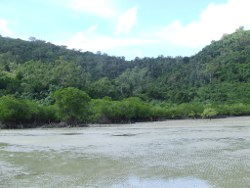|
|
Mangrove usesIn Australia, mangrove habitats are significantly represented in nature reserves, sanctuaries, national parks and biosphere reserves where they have significant recreation and ecotourism values. Mangroves trap sediments and so contribute to land building, preventing erosion and excessive shifting of coastlines. They also provide habitat for many commercially collected species such as fish and crabs. Mangroves are critical in the sequestration and storage of carbon, and are known as blue carbon ecosystems. Australian coastal Aborigines and Torres Strait Islanders and people of South East Asia have had a very close association with mangroves. Mangroves have long functioned as a storehouse of materials providing food, medicines, shelter and tools. Mangrove communities provide food directly and indirectly e.g. fish, crabs, shellfish, prawns and edible snakes and worms. The fruit of certain species, including the nypa palm, can be eaten after preparation along with the nectar of some of the flowers. The best honey is considered to be that produced from mangroves, particularly the river mangrove (Aegiceras corniculatum). Medicines are derived from mangroves. Ashes or bark infusions of certain species were applied to skin disorders and sores, including leprosy. Headaches, rheumatism, snakebites, boils, ulcers, diarrhoea, haemorrhages and many more conditions are traditionally treated with mangrove plants. The latex from the leaf of the blind-your-eye mangrove (Excoecaria agallocha) can cause blindness, but the powerful chemicals in it can be used on sores and to treat marine stings. The leaves are also used for fishing—crushing the leaves and dropping them in water stupefies fish which float to the surface. Certain tree species, notably the cedar mangrove, cannonball mangrove (relatives of the red cedar) and the grey mangrove, are prized for their hard wood and used for boat building and cabinet timber as well as for tools such as digging sticks, spears and boomerangs. The fronds of the nypa palm are used for thatching and basket weaving. Various barks are used for tanning, pneumatophores (peg roots) make good fishing floats. The wood from yellow mangroves (Ceriops) has a reputation for burning even when wet. Mangroves are an assetMarine plants are a vital community asset supporting important commercial, recreational and indigenous fisheries. Mangroves are an integral part of this community resource. Mangroves protect the coast by absorbing the energy of storm-driven waves and wind. The only two yachts undamaged by Cyclone Tracy in Darwin in 1974 were sheltered in a mangrove creek. In 2006, mangroves protected vessels and the coastline during Cyclone Larry in far north Queensland. The damage bill would have been much higher if it wasn't for the existence of intact mangrove forests. As well as providing a buffer for the land, mangroves also interact with the sea. Sediment trapped by roots prevent silting of adjacent marine habitats where cloudy water might kill corals or smother seagrass meadows. In addition, mangrove plants and sediments have been shown to absorb pollution, including heavy metals. Mangroves are also very effective at storing carbon. Worldwide, vast tracts of mangroves have been destroyed to make way for unsustainable development; Queensland still has relatively large areas of Australia’s tallest and best developed mangroves. The Report on the Effects of the January 2011 Flood on the Mangrove Communities Along the Brisbane River summarises the effect of the January 2011 flood on the mangroves between Breakfast Creek and the Bremer River in South East Queensland. ProductivityA teaspoon of mud from a north Queensland mangrove forest contains more than 10 billion bacteria. These densities are among the highest to be found in marine mud anywhere in the world and are an indication of the immensely high productivity of this coastal forest habitat. A square meter of mangrove plants produces about 1kg of litter per year (mainly leaves, twigs, bark, fruit and flowers). Some of this is eaten by crabs, but most must be broken down by bacteria and fungi before the nutrients become available to other animals. Dividing sometimes every few minutes, bacteria feast on the litter, increasing its food value by reducing unusable carbohydrates and increasing the amount of protein—up to 4 times on a leaf that has been in seawater for a few months. Fish and prawns eat the partly decomposed leaf particles. They, in turn, produce waste which, along with the smallest mangrove debris, is taken up by molluscs and small crustaceans. Even dissolved substances are used by plankton or, if they land on the mud surface, are browsed by animals such as crabs and mud whelks. This process is not confined to the mangroves. While some litter is recycled on the spot, this system is one of the few to export much of the organic matter it produces. Studies of the mangroves at the northern end of Hinchinbrook Island have shown that they export more than 12,500t of litter a year into Great Barrier Reef waters. This material is deposited over 260km2 of seabed. Here bacteria densities are almost as high as those in the mangrove mud and they do much the same job, breaking down the litter to be consumed by bottom-dwelling fauna, e.g. prawns and fish. The seafood industry is the fifth largest primary industry in Queensland, with an annual commercial catch worth several hundred million dollars. Many commercially caught fish and prawns depend directly on mangroves at some time in their lives or feed on food chains leading back there. Since those species making up the remainder of the catch probably also owe much to nutrients exported from the mangroves, these coastal forests can be seen as one of our major assets. Protection and managementFor mangrove protection and management see programs, policy and legislation. Additional informationLast updated: 14 November 2019 This page should be cited as: Department of Environment, Science and Innovation, Queensland (2019) Mangrove uses, WetlandInfo website, accessed 8 May 2025. Available at: https://wetlandinfo.des.qld.gov.au/wetlands/ecology/components/biota/flora/flora-structural/mangroves/mangrove-use.html |

 — Department of the Environment, Tourism, Science and Innovation
— Department of the Environment, Tourism, Science and Innovation


